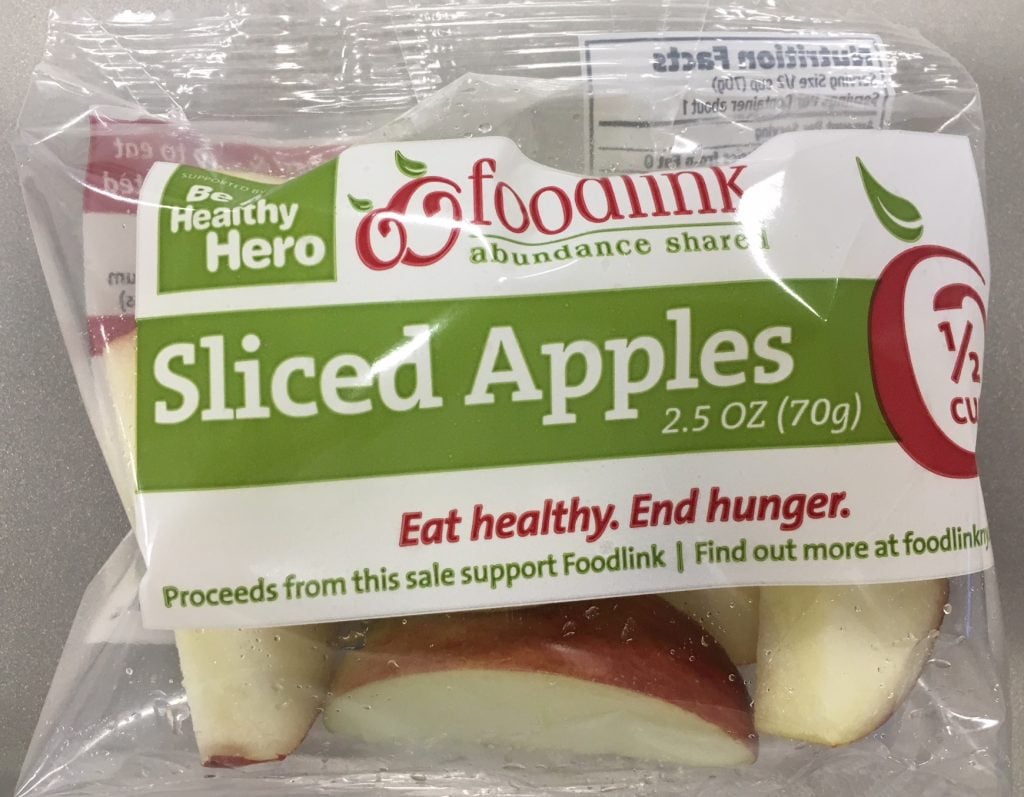Everybody understands the appeal of a sliced apple over a whole one. For Foodlink of Rochester, NY, that appeal has translated into a way to get kids to eat healthier food, a boost for the local economy, and an annual revenue stream for the food bank of more than $200,000.
Since 2017, Foodlink has been using a sophisticated, up-to-90-foot long piece of machinery to wash, slice and bag huge quantities of apples purchased from area farms. With the addition of a second processing shift in fall 2018, Foodlink now produces about 50,000 bags of sliced apples a week for distribution to local schools.
The apple-slicing effort has been a boon to the local economy on several levels. Foodlink purchases apples from more than 30 farms across central and western New York and uses local distributors to move the apples to area schools. And it is training the local workforce in skills related to food processing, recently adding new positions to cover its second apple-slicing shift. On top of it all, kids are far more likely to actually eat the apples because they’ve been sliced.
“It’s a true social enterprise,” said Mark Dwyer, communications manager at Foodlink.
Before Foodlink came onto the apple-slicing scene, some area school kids were being given apples from Washington state, a situation that defied logic, given that nearby Wayne County is one of the top apple-producing counties in the nation. Foodlink founder Tom Ferraro made this realization right around that time that he gained another insight: that kids are 73% more likely to eat fruit when it’s sliced, according to a study from Cornell University.

Ferraro (now deceased) used those two pieces of information to create what was originally a modest apple-slicing operation. In the early days, workers used a simple contraption to slice two apples at a time, and manually bagged the output. The food bank’s move into a state-of-the-art culinary training kitchen at the end of 2016 gave it the opportunity to upgrade to an elaborate, automated slicer and significantly ramp up its business.
Now Foodlink is producing 500 cases of apples a week (each case holds 100 bags), up from less than 50 cases in the early days, allowing it to expand its number of partners. Currently, it has relationships with eight distributors, which move the apples out to local schools, as well as a private label contract with Zee Zees, an arm of the National Food Group focused on providing healthier snack options for kids.
All that activity means Foodlink is on track to exceed its goal of bringing in $205,000 for fiscal year 2019. All of that money will go back into other programs, such as kids meals and mobile pantries. “There are several other programs we do that we would love to sustain with the apple-slicing money,” Dwyer said.
Along the automated conveyance, the apples go through ten main steps, including a quick bath in citric acid to prevent browning and a trip through a metal detector to ensure safety from the metal slicing blades. Foodlink received back-to-back farm-to-school grants from New York State totaling more than $150,000, helping to pay for the equipment. It also benefited from government and private donations as part of a $5 million capital campaign for its new kitchen.
Given the complexity of the equipment, it’s natural that not everything has gone smoothly. Foodlink’s near 90-foot conveyor is down to about 50 feet currently because the washing component was not compatible with the slicer and has been disabled. For the time being, the food bank is using a big commercial sink to wash the apples manually. “Figuring out this equipment has been one of the biggest challenges,” Dwyer said. He advised having someone on staff or on call with expertise in troubleshooting machinery.
Foodlink’s focus now is on growth. It is working on getting an SQF certification for food safety, which would allow it to work with more distributors. And it is investigating new products, such as sliced carrot sticks or cucumber coins. “Even though we increased production so much in the last year, there’s still so much room for growth,” Dwyer said.









